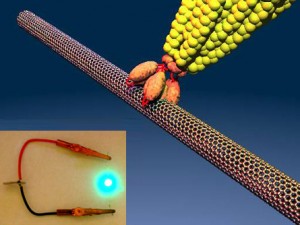To say that your battery is “smoking” would normally be the sign of a failed circuit, but researchers at the A. James Clark School of Engineering and College of Agriculture and Natural Resources at the University of Maryland may be putting a virus that’s bad even for tobacco to good use in creating a battery that may be up to 10 times more powerful than today’s best lithium cells. Professor Reza Ghodssi, director of the Institute for Systems Research and Herbert Rabin Professor of Electrical and Computer Engineering at the Clark School, is “harnessing and exploiting the ‘self-renewing’ and ‘self-assembling’ properties” of the Tobacco Mosaic Virus (TMV), which in its unrestrained natural state destroys tobacco, tomatoes, peppers and other leafy green things. The idea that battery creation is a self-directing event is belied by the University’s video.
Scientists found, “They can modify the TMV rods to bind perpendicularly to the metallic surface of a battery electrode and arrange the rods in intricate and orderly patterns on the electrode. Then, they coat the rods with a conductive thin film that acts as a current collector and finally the battery’s active material that participates in the electrochemical reactions.” This increases electrode surface area, allows faster charge/discharge cycles and provides up to 10 times the energy storage of conventionally-produced cells.
Cooperation among multiple disciplines may make the breakthrough commercially feasible, as evidenced by statements from James Culver, a member of the Institute for Bioscience and Biotechnology and a professor in the Department of Plant Science and Landscape Architecture (can these guys remember their titles?), and Chunsheng Wang, a professor in the Department of Chemical and Biomolecular Engineering.
“The use of the TMV virus in fabricating batteries can be scaled up to meet industrial production needs. ‘The process is simple, inexpensive, and renewable,’ Culver adds. ‘On average, one acre of tobacco can produce approximately 2,100 pounds of leaf tissue, yielding approximately one pound of TMV per pound of infected leaves,’ he explains.” Incidentally and happily, the manufacturing process neutralizes the toxicity of the virus.
The ability of the virus to bind itself to metal subtrates allows dropping several steps from more traditional battery creation and provides a better battery. “Our method is unique in that it involves direct fabrication of the electrode onto the current collector; this makes the battery’s power higher, and its cycle life longer,” added Wang.
Maryland’s breakthrough may owe something to earlier work, as Dr. Seeley noted with this link, concerning research by Massachusetts Institute of Technology materials scientist Angela Belcher.
Ms. Belcher and her team distinguished themselves by creating viral anodes and cathodes in 2009, thus producing the first viable viral battery. At that time, she explained that the discoveries could lead to batteries with 10 times the storage capacity of the best currently available and foresaw their use in vehicles.
Her work combines carbon nano-fibers with genetically modified viruses to make a battery that requires only low temperature, low pressure manufacturing techniques and only water-based solvents. Thus, the battery is “green” in its manufacture as well as in its use. While artificial means of creating nano particles can be labor and cost intensive, the viruses readily coat themselves with iron phosphate. When combined with carbon nanotubes acting as a cathode, the coated viruses help produce a highly efficient battery.

Viruses programmed to grow an iron phosphate shell, then bind to carbon nanotubes. Inset shows biological virus battery powering a green LED.
In March, 2009, MIT President Susan Hockfield took the prototype battery to a press briefing with President Obama. Both Ms. Belcher and the President spoke of the need for federal funding to advance such scientific breakthroughs. This year, Ms. Belcher and her colleagues have published an impressive array of papers, including “Nanostructure design of amorphous FePO4 facilitated by a virus for 3 V lithium ion battery cathodes” with co-author Yun Jung Lee in the Journal of Materials Chemistry. The pair achieved some success with the technique, noting the efficiency of the product and the inexpensive nature of their process. “The first discharge capacity at a discharge rate of C/10 and 1C was 165 mA h g−1 (93% of the theoretical value) and 110 mA h g−1, respectively. These electrochemical properties are comparable to the best reported values for a-FePO4 synthesized at high temperature. In this study, we set the important step for the practical applications of biological approaches in designing and fabricating energy devices, which may be a promising alternative to the traditional processing techniques that consume energy and are costly.”
